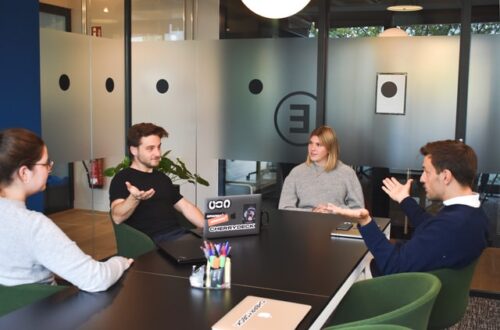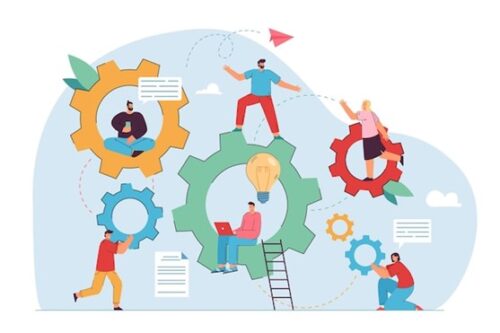An important aspect of Whole Brain Technology is the understanding individuals brain dominance South Australia and thinking preferences. Through Whole Brain Technology, you can measure different thinking preferences by determining the degree to which four thinking styles are dominant. Essentially, Whole Brain Technology is based on the Herrmann Brain Dominance Instrument (HBDI™). This is the global standard for measuring brain dominance and thinking preferences. South Australian businesses can benefit from Whole Brain Technology’s scientifically proven approach to thinking better.
You cannot change your mind, but you can change the way you think through the HBDI®. The focus of the discussion is on thinking preferences and how they vary from person to person.
The model looks like this. What is it?
Developed by Ned Herrmann, the HBDI Whole Brain Thinking Model is based on the HBDI Whole Brain Thinking Model. In terms of thinking, communicating, and making decisions, each individual has four quadrants based on the psychometric model. A method for measuring preferences in terms of thinking and processing styles.
Today, the key to success is developing employees skills
It cannot be overstated how important it is for employers to develop their employees’ skills in today’s society. This tool gives your employees the ability to assess their thinking styles based on the Herrmann Brain Dominance Instrument (HBDI™). This test identifies how they think emotionally, analytically, structurally, and strategically. Individuals also gain a deeper understanding of themselves as a result of it. A simple assessment system known as the HBDI™ was developed by Ned Herrmann in the 1970s. Research and innovation have contributed to the validity of the HBDI™ over the past twenty years. HBDI™ analysis has been performed on over 2 million individuals worldwide.
HDMI® is popular among all South Australian businesses because it provides deep understanding without taking days to develop. You gain an understanding of it fairly quickly, and you can then develop a deeper understanding of it.
HBDI™ goes beyond assessments
This assessment is intended to fill in the gaps left by the other assessments. In contrast to most assessments which result in only a single report, the HBDI™ is capable of offering a wide range of applications. The first step is figuring out which thinking style you prefer.
A number of workplaces use HBDI™ for coaching as well. In addition to being great for teamwork, it can be used to understand how an organisation thinks as a whole. It has a greater impact the more you use it. Ultimately, it is all up to you.
HBDI™ stands for what?
Herrmann is represented by the letter “H.”. Developed the Whole Brain® concept and created the HBDI® instrument, Ned Herrmann is the man behind it.
Ned was the first individual to apply the study of the brain to the field of business. Initially, it was designed to address a very specific business problem. The Management Development section of GE was headed by Ned Herrmann. GE managers were asked to be more creative under Ned’s leadership. During this process, Ned developed what has come to be known as the Whole Brain® Model and Whole Brain® Thinking.
Brain is the “B” in HBDI®. The brain played an important role in Ned Herrmann’s work.
As technology has enabled us to view the brain inside, our understanding of how it works has exploded over the last 30 years. It is becoming apparent that neuroscience is beginning to have a significant impact on business and education as well as on our health and well-being.
During the course of his research, Ned Herrmann examined the brain in terms of its application and what it does, which is thinking. As a result of Ned’s efforts, The Whole Brain® Model has been developed.
According to the Whole Brain® Model, there are four quadrants, which represent the four major styles of thinking. As a result, you are able to better understand people and their thinking.
Yellow, red, green, and blue make up the four quadrants.
Dominance is the “D” in HBDI®. According to the HBDI®, you are placed into the categories that correlate with your dominant characteristics. As we go through life, we develop dominant thought patterns and preferences. As a result, the HBDI® measures these factors.
A brief overview of each type is given below:
BLUE: A brain quadrant with a blue colour represents the fact-based area of the HBDI®. High preferences here are usually associated with logical and rational thinking. Their thinking tends to be analytical and they are often more drawn to maths, technical, and problem-solving processes.
- Aristotle, Adam Smith, and Bill Gates are famous blue.
- An engineer is an example of a blue profession.
- As a rule, blues are concerned with the what of a given situation.
Green: Located in the green quadrant of the HBDI®, this area of the brain is based on form. In this instance, they were the most preferred, having a strong organised and sequential nature. There is a plan and a detailed approach to their approach, often wanting to know how we will reach our destination and what the next steps will be.
- George W. Bush and Queen Elizabeth II are famous green.
- Project manager is an example of a green profession.
- Any given situation, greens are interested in the when.
Red: The HBDI® red quadrant corresponds to the brain area that is concerned with feelings. Communicators with a high preference in this area are likely to be excellent communicators. Their interpersonal skills are excellent, and they are often musical as well as spiritual in their outlook.
- A famous red was Mother Teresa, Martin Luther King and Jimmy Carter.
- Teaching is an example of a red profession.
- In given situations, reds are interested in who is involved and care about relationships.
Yellow: An area of the brain based on the future is the yellow quadrant of the HBDI®. The people with the highest preference here are those with ideas. In addition to being imaginative, holistic, and conceptual thinkers, they are also creative.
- Famous yellows are Einstein, Jeff Bezos and Amelia Earhart.
- Entrepreneur is an example of a yellow profession.
- In any given situation, yellows want to know why.
It’s important to keep in mind that you could be any combination of these. There are times when you are just one of them. Regardless of which quadrant we use, we all have preferences, and these preferences can change depending on the situation.
Instrument is the “I” in HBDI®. The instrument was developed by Ned Herrmann to give people an understanding of their thinking preference in terms of The Whole Brain® Model.
The HBDI® asks you 120 questions. These questions come from a range of different areas of life: work, home, hobbies, outside interests, school, education, problem-solving, creativity. That information makes up your HBDI® profile. We can assist you regardless of whether you reside in South Australia or another state/territory.
HBDI®: The Power of Innovation
We are proud to present a valid, research-based, and clear report to South Australian businesses. The majority of people who receive the HBDI® say, ” Yes, I understand.” the moment they receive it. I see. Thanks for clarifying. That explains the situation.
They walk away with a better understanding of their thinking preferences, without spending too much time thinking about it.
In addition to being highly actionable, it is capable of being applied to all contexts, and it can be implemented quickly. Understanding your thinking preferences applies to all contexts, regardless of what you’re doing. The same model, the same instrument, the same applications.
In addition to being non-judgmental and simple, it gives you the ability to develop as an individual.
There is a positive message, a personal memory, and a focus on people. There is no right or wrong in the HBDI®, as it is designed such that there is no good, there is no bad, there is no right or there is no wrong. It is important to note that each quadrant is equally valid. In some cases, it may be more appropriate to choose one over the other, but all are acceptable. Everything we do is centred around people and putting their needs first. Not just you, but anyone with whom you work and interact in your business or social life in South Australia is affected.
Rather than an assessment instrument, the instrument is designed to encourage self-development. Using your HBDI® Profile, you can see how you need to grow to achieve your goal.
These are a few suggestions for how to make use of HBDI® at work
Preparing your presentation:
You should ensure that your presentation offers something for everyone. For the blues, there are facts, for the reds it is stakeholder insight, for the yellows, there is the future, and for the greens, there are the next steps.
Sending an email:
The next time you reply to an email, try to guess which colour they are based on their email, and then tailor your next email to be more in line with that colour.
Attendance at team meetings:
Think about which colour wrote the presentation at your next meeting. How about asking yourself which colour would be the most appealing to you? Let’s solve a problem with HBDI®. As you move from colour to colour, ask, “Blue, what knowledge do we have about this problem? ” You start with blue and ask, “What do we know about this problem and what do we need to know to solve it? ”
Finally, The Whole Brain™ Model can help you anticipate what people will seek and respond to during communication. This will help you avoid incorrect interpretations that slow progress by modifying your messages for each type of thinker. This is also one of the benefits of the model. Whenever stakeholders learn to respect each other’s contributions and complement each other’s styles, teamwork and communication will invariably be successful.
What are you waiting for? Let’s book your team right away.
Our leadership programs such as elearning programs and Herrmann Brain Dominance South Australia cover a wide range of topics, so there’s bound to be one that works for you.
Our goal is to help businesses achieve positive, long-term behavioural changes and to enhance the effectiveness of leaders within their organisations by using profiling tools.
The following are some ways that leadership and employees can benefit from HBDI testing:
- Make your team more productive and effective by improving the way they think and approach different opportunities and challenges
- Become more effective at selling and negotiating
- Enhance the performance of the Sales and Customer Service departments
- Increasing the effectiveness of decision making
- Gain a higher level of productivity
- Improve communication internally
- Consolidate conflict resolution
We can provide you with more information and Herrmann Brain Dominance South Australia within your business, contact us. 0754 992 406












